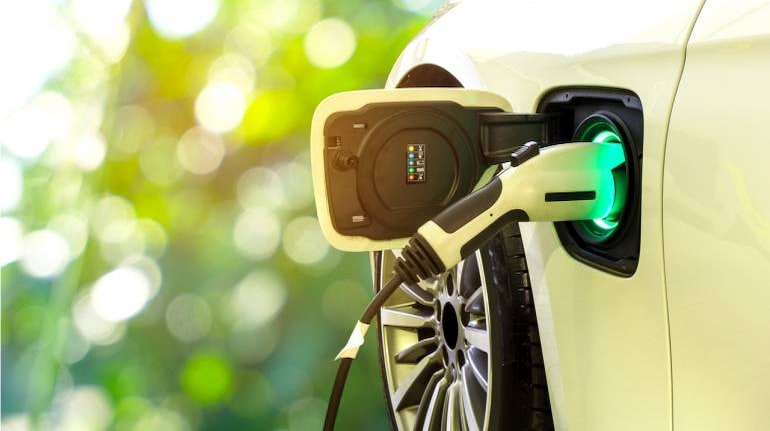



Dear Reader,
The Panorama newsletter is sent to Moneycontrol Pro subscribers on market days. It offers easy access to stories published on Moneycontrol Pro and gives a little extra by setting out a context or an event or trend that investors should keep track of.
Electric vehicle (EV) sales are gathering momentum across the world. Government incentives and climate change consciousness among customers are driving the adoption.
Forecasts suggest that the EV market penetration will grow from the present single digits to about 40-50 per cent of total new passenger vehicle sales by 2030. India's EV sales surprised positively, as EV sales have already crossed the 4-lakh mark in FY2022 (as per figures available till the third week of March). Led by two-wheelers and supported by incentives under FAME II, this is four times higher than sales clocked in FY2021.
But the fire lit under commodity prices by the Russia-Ukraine conflict could prove to be a spanner in the works. Will it change the narrative for EVs in the near term?
As it stands, rising petrol and gas prices have made it cheaper to operate an EV. In India, the shift to electric two-wheelers (e2W) is in the spotlight, although buses and three-wheelers are catching up fast too. While it may be too early to judge the success and market share gains of individual companies, names such as Hero Electric, Ather Energy, Okinawa, Ola Electric, etc. are frontrunners in e2Ws, while Tata Motors is ahead in electric cars, even as Mahindra and Maruti are making the right noises.
However, thanks to geopolitical risks and sanctions on Russia after its invasion of Ukraine, lithium and nickel prices, key inputs in the manufacturing of EV batteries are surging, leading to input cost inflation.
A Credit Suisse Commodities Team report estimates lithium prices to remain elevated at least until 2024, as lithium supply is expected to be critically tight until 2025. Another report by Fitch Ratings points out that higher grade Class 1 nickel -- nickel content of 99 percent or more -- is required for EV battery production, and is largely mined in Russia, from where supplies are now uncertain, even if we ignore the impact of higher prices for the moment.
The heat from rising input costs, it is reckoned, is leading to cost inflation in batteries that is bound to show up in higher EV prices. Batteries account for 40-50 per cent of the total cost of EVs. Global manufacturers such as Tesla, China’s BYD and Xpeng are some who have announced price increases already.
In India too, EV makers across segments, be it two-, three- or four-wheelers, are set to raise prices. Media reports citing experts are estimating price hikes in the range of 6-10 per cent starting next month, although some such as Tata Motors, Ola Electric and Ather Energy have already increased prices.
Will this derail growth rate in EVs and the milestones for EV adoption set by various countries?
Speaking of India, it is still far behind some of its Asia peers. Industry analysts feel that commodity inflation through the pandemic was absorbed by many manufacturers in order to push sales. Any further accommodation would be tough and lead to further compression in margins. However, increasing vehicle prices would reduce the edge that EVs have developed over traditional fuel vehicles and might dampen EV sales.
Sooner than later, the government would have to do away with subsidies that are supporting the current spurt in EV sales. Further, the Russia-Ukraine conflict has begun precipitating supply chain and logistics bottlenecks, which will hit EVs too, given that India lacks local supplies.
While all of this may sound gloomy, a more optimistic viewpoint is that the higher input costs of existing EV inputs and their paucity, could trigger research on alternate fuels. Although, any breakthroughs on that front will be visible only in the long run.
Investing insights from our research team
How to make the most of volatile and unpredictable markets in 2022
CCL Products: Correction spells an opportunity
Antony Waste Handling Cell: Business is coming back
What else are we reading?
The quick and the dead: Decoding Zomato’s 10-minute delivery gamble
Why the US stock market is less volatile during wars
Start-up Street: What an uncertain IPO environment means for PE-VC funding
Microfinance gets a leg-up with new regulation
Chart of the Day | China’s steel output slump continues
Fosun parentage yielding tangible benefits for Gland Pharma
Pricing power key for capital goods firms as input costs spiral on Ukraine flare-up
Top oil traders warn prices could breach $200 a barrel (republished from the FT)
Technical Picks: Gold mini, Tata Steel, SAIL, Kotak Mahindra Bank and Jindal Steel Power (These are published every trading day before markets open and can be read on the app)
Vatsala Kamat
Moneycontrol Pro
Discover the latest Business News, Sensex, and Nifty updates. Obtain Personal Finance insights, tax queries, and expert opinions on Moneycontrol or download the Moneycontrol App to stay updated!
Find the best of Al News in one place, specially curated for you every weekend.
Stay on top of the latest tech trends and biggest startup news.